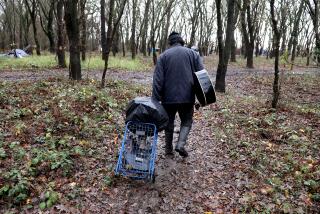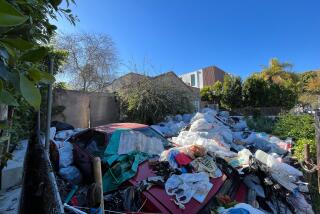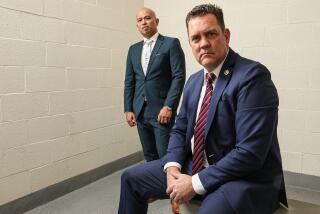Foreclosures and resulting blight infest once-safe neighborhoods
William Perez has been waiting a long time to tell someone all the sad and crazy things he’s seen.
Perez runs a crew that crisscrosses Los Angeles and the Antelope Valley doing the dirty but essential job of cleaning up homes that have been foreclosed and then trashed by humans and neglect.
“The good news about this place,” he told me as we stood inside one such property on Wilmington Avenue in Watts, “is that there’s no fleas.”
No fleas, but plenty of trash, and an odor most foul. The people living there had been evicted six weeks earlier. They left behind mattresses, clothes and boxes of cereal. Some days later, thieves broke in, punched holes in the ceiling and stole about $100 worth of copper plumbing.
Cascading water then soaked everything the family had left behind. Drug users, pimps and assorted other criminals also made use of the vacant property. “My understanding is that there was a girl that was raped here,” said Perez, a subcontractor hired by a company that maintains bank-owned properties.
This is what happens too often when a foreclosed home passes to the ownership of huge, distant banks — in this case, the Bank of New York Mellon. There are tens of thousands of such properties in Southern California.
“I’ve gone to houses where people are literally setting fire to the house when I get there,” Perez told me. “The saddest thing is seeing the messages people leave on the walls.” In the Wilmington Avenue home, we found pictures of family gatherings — and the sickening detritus left by people abusing their bodies with methamphetamines.
All the filth I saw opened my eyes: to the devastation caused by people addicted to drugs, by banks addicted to profit, and by a city government too weak and ineffective to protect its poorer residents.
Perez told me the main reason foreclosed homes fall into disrepair is that there are simply too many for his crews to maintain. And the reason there are so many, we all know, is that during the last boom lenders doled out home loans like candy to people who couldn’t afford them.
If it were fixed up, the 1,200-square-foot house on Wilmington Avenue might now fetch $140,000. But in 2007, it sold for $281,500.
“At the top of the market,” said Jesse Alvarez, a broker who manages the property for the loan servicer, Bank of America. Unable to pay the mortgage, the owners were evicted April 5.
Apparently, it doesn’t take long for word to spread in a neighborhood that a property is open for criminal activity. Right away, neighbors on Wilmington Avenue said, they noticed new people entering it.
“You see prostitutes coming and going,” said Maria Algutria, a retiree and foster mom who owns a home two doors down.
Like an open sore, a vacant home can become the source of an infection. That’s why the city of Los Angeles passed an ordinance in 2010 that fines banks $1,000 for each day their foreclosed properties are “blighted.”
In theory, the vandalized home I saw on Wilmington Avenue should have filled up the city coffers with about $40,000 in such fines. But, surprise, surprise: The city never collects them.
“Under that ordinance, our people would be required to go out once a day to see the property,” said David Lara, a spokesman for the city’s Department of Building and Safety, whose inspectors are tasked with enforcing the law. “We don’t have the level of resources to do that.”
Call me naive, but I still find it shocking to hear a government official, in the United States, admit that a recently enacted law isn’t enforced. Why did the City Council pass it in the first place? For show? Is it governing that’s going on over in City Hall, or just theater?
I’d like to call it a farce, but it’s really a tragedy to the good people in South L.A. They deserve, at the very least, a city government that enforces a law designed to protect their families and their property values.
The Alliance of Californians for Community Empowerment and Good Jobs L.A recently conducted a survey of 400 bank-owned properties in South L.A. and found that about half were in a state of blight and half of those in “severe” blight.
Last week, they took me on a quick tour of three such homes, including the one on Wilmington Avenue. At each, we were greeted by outraged owners of neighboring properties.
“I told my kids, you can’t walk past this place,” said Julian Coria, 52, and the father of two young children, as we stood outside a home on West 56th Street. “They used to ride their bikes on this street. Now I won’t let them.”
When I arrived at the third foreclosed property, a little bungalow on South New Hampshire Avenue, Good Jobs L.A.’s Melissa Chadburn told me she had just spotted a woman in her 20s inside. The woman was wearing jeans, a red wig and an otherworldly smile.
“She was having a good day,” Chadburn said, with mordant irony. “Every day is a dream for her.” Stepping inside, I was greeted by a scent of decay and human waste so powerful that I gagged and took a step back. Then, at my feet, I saw a backpack with homework pages spilling out: a lesson in English grammar.
The neighbors spoke of seeing adolescent girls as young as 12 enter the vacant home during the day.
“When we started looking for these houses, I expected to find blight, to find squatters,” Chadburn told me. “But I didn’t expect to see these kinds of stories.”
Outside, in the backyard, all was pleasant. Trumpet-shaped lavender flowers grew from a trellis. You could almost feel the loving hands of the family that once lived there.
More to Read
Start your day right
Sign up for Essential California for news, features and recommendations from the L.A. Times and beyond in your inbox six days a week.
You may occasionally receive promotional content from the Los Angeles Times.







